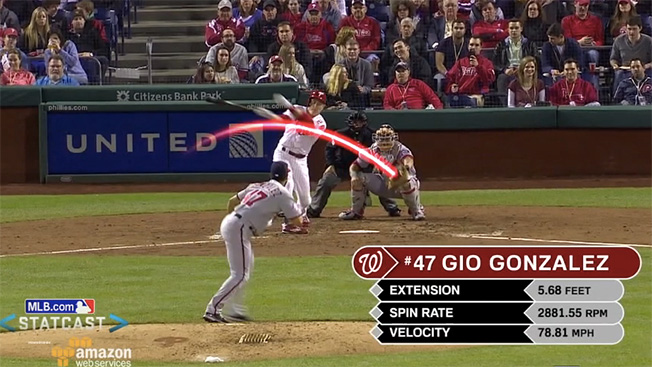What’s The Functioning Behind MLB’s Pitch Tracking System? ‘Statcast’ Explained
Even though baseball is a classic American sport, it is always changing. Major League Baseball is benefiting from a variety of new technological advances that are keeping it current, from pitch tracking to virtual reality training. Additionally, the growth of the sport as a result of technology improvements is more important than simply utilizing equipment. ‘Statcast’ helps give details.
What’s The Functioning Behind MLB’s Pitch Tracking System? ‘Statcast’ Explained
Modern monitoring technologies like Statcast make it feasible to gather and analyze vast amounts of baseball data in ways that were previously unthinkable. Since Major League Baseball Advanced Media placed pitch tracking equipment in every Major League stadium more than ten years ago, baseball has evolved in our minds and in our consumption of it. Statcast may be seen as the next natural progression in this development.
Statcast confirmed Randy Rosenberg had the thinnest skin of any umpire this season. https://t.co/CbRZWK6ZNE
— Codify (@CodifyBaseball) November 19, 2023
It was a move that opened the door to a whole new era of baseball fans, and Statcast expands on that idea by tracking all the things the prior system accomplished in addition to much more. After a limited trial run in 2014, it was deployed in all 30 parks in 2015.
There’s no escaping radar and camera technology, despite the denials of many ardent supporters who think it might provide someone an advantage at MLB betting sites. Cameras and radar devices detect and assess each pitch that is made. This gives important information on spin, trajectory, and pitch velocity.
Top 10 Longest Ranger Home Runs of the Statcast era
T-9th:
Rougned Odor, 8/19/2017466
110.7 EVPitcher: Dylan Covey (White Sox) pic.twitter.com/xGwoJ6iGjI
— slightly concerned Rangers fan (@DepressedRanger) November 16, 2023
Reviewing pitches allows a lot of individuals and teams to improve their technique. To perform better, they might adjust their grip and release spots. Coaches can develop strategies too to maximize their players’ performances.
Over the past few years, seven cameras have been following players and hitting balls at a relatively slow 50 frames per second, while five cameras have been tracking pitches at 100 frames per second. But there was an improvement this season.
As it happened, 100 frames per second was insufficient to capture all the data MLB needed for Statcast. It desired speedier data collection.
Top 10 Longest Ranger Home Runs of the Statcast era
6th:
Shin-Soo Choo, 9/22/2019472
111.8 EVPitcher: Tanner Roark (A’s) https://t.co/OVklXfRbrV pic.twitter.com/FwXtK9Ji0p
— slightly concerned Rangers fan (@DepressedRanger) November 16, 2023
Hence, new pitch-tracking cameras that record at 300 frames per second were unveiled this season. With the ability to record a pitch’s velocity, spin rate, seam orientation, horizontal and vertical break, and more in that split second, they provide a virtual biography for every single pitch.
Security concerns grow as technology does. The MLB‘s use of cutting-edge technology is commendable, but there are also drawbacks. Although face recognition technology may be used by stadiums to monitor potentially troublesome individuals, privacy issues have been raised by fans.
Top 10 Longest Ranger Home Runs of the Statcast era
2nd
Joey Gallo, 7/20/2018495
114.3 EVPitcher: Garrett Richards (Angels) https://t.co/URLDNJYalB pic.twitter.com/7FLboJCAHX
— slightly concerned Rangers fan (@DepressedRanger) November 16, 2023
Surveillance system deployment requires caution. For everyone involved with MLB, ensuring that technology protect privacy is an ongoing problem. Madison Square Garden is a prime example; it faced criticism for denying admission to individuals based only on their facial recognition software.
It’s evident that the MLB is always breaking new ground. It is advancing the sport to unprecedented levels by utilizing data, simulation, and security technology. It will be intriguing to observe what the next generation has to offer as we go through the future has in store for this timeless sport.
This 435ft MOONSHOT by Triston Casas is the furthest hit oppo home run hit by a lefty at Oracle Park in the Statcast Era!
If that sounds crazy, it's because it is 😱 https://t.co/uUnJCI917T pic.twitter.com/2PmhRA1m6b
— Nyanasaur (@Nyanasaur) November 11, 2023
When you compare this degree of detail to what Statcast offered even a few years ago, it’s astonishing. The system’s initial release in 2015 was only able to infer the release point of a pitch from changes in velocity; it was unable to provide the precise release point of a pitch. Radar and cameras were first employed by Statcast, but none of them ran as quickly as they do now. However, the existing method eliminates the necessity for such hunches.
FOR MORE SPORTS COVERAGE-
FedEx Field Ran Out Of Water During Commanders Vs Giants Game


